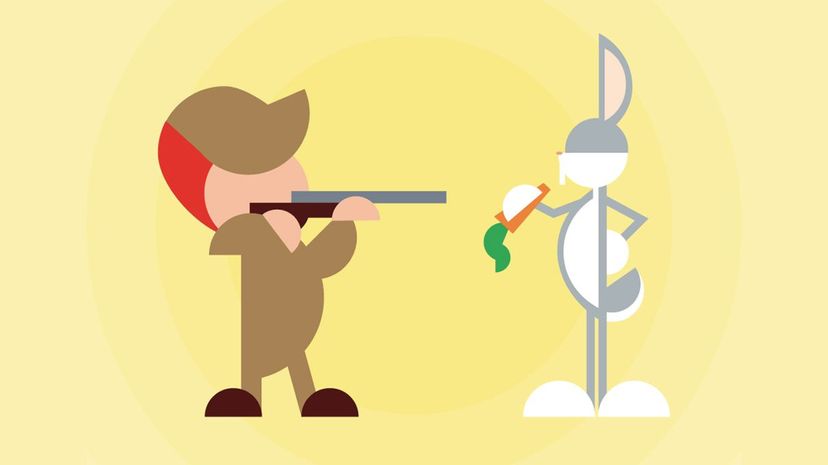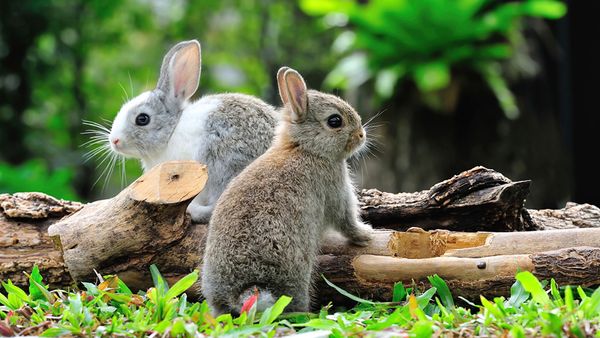
Bugs Bunny, a wisecracking Warner Bros. cartoon character with a Brooklyn accent, has been around since the 1940s. Generations grew up watching his antics, hearing his catchphrase: "Eh ... what's up, Doc?"
A carrot-waggling trickster who occasionally parrots Shakespeare, Bugs Bunny is — as perpetually vexed huntsman Elmer Fudd says — a "wascally wabbit," right? Well, maybe not. Bugs may be a rabbit, but some clues point to him being a hare, a close relative but different species, instead. Determining whether this character is on the rabbit or hare side of the family tree is almost as tricky as Bugs himself. And it's been unclear since the beginning.
Advertisement
A Bugs-esque character appeared in a cartoon in 1938, but Bugs Bunny as we'd recognize him today first appeared on July 27, 1940, in a cartoon called, "A Wild Hare." His character was well-received by children and adults alike. This, and the fact that his debut coincided with America's golden age of animation, helped secure his spot as one of Warner Bros.' main cartoon characters.
During World War II, Bugs got another boost. Several Air Force troops, including the 380th Bombardment Group, chose Bugs Bunny as their mascot, and the Marine Corps designated him an honorary Master Sergeant. He starred in propaganda cartoons made specifically for American soldiers stationed in Europe, as well as government advertisements for wartime bonds. Bugs Bunny went on to star in 150 films, appear as the first animated character on a postage stamp, receive a star on the Hollywood Walk of Fame and be ranked No. 1 on a list of the 50 greatest cartoon characters compiled by TV Guide.

Although many have attempted to identify what set Bugs Bunny apart from the cartoon crowd, perhaps the late Chuck Jones — the long-time writer and producer of Bugs Bunny — described it best.
"[My father's] attitude was that Bugs already existed and they were just writing about him," his daughter, Linda Jones Clough, told Smithsonian. "He would come home in the evening and say to my mother, 'You won't believe what Bugs Bunny said today!' 'What do you mean?' she would say. 'You wrote it.' 'No I discovered under the circumstances that this is what he would say.'"
Whether Bugs Bunny was conceived as a rabbit or a hare is not as clear. Although the word "bunny" is part of his name, many of his cartoons had "hare" in the title, including "Bill of Hare" and "Fallin' Hare." But that could just be wordplay rather than scientific nomenclature.
Before we hop to the wrong conclusion, let's take a look at some of the characteristic differences between rabbits and hares. Although rabbits and hares are all from the Leporidae family, they are classified under 9 different genera (8 rabbit genera and 1 hare genus) and 53 species (21 distinct rabbit species, 32 for hares) — and they start life in markedly unique ways.
Hares are pregnant about 42 days and deliver fully developed newborns, called leverets, while bunnies have a 30-to-31 day gestational period and birth undeveloped kits without fur, and without the ability regulate their body temperatures. Hares also have uniquely jointed skulls unlike those of any other mammal.
Hares have long ears, longer hind legs and are typically gray in color, which seems to tip the scale in favor of Bugs Bunny being a hare. "Rabbits, also known as bunnies, have short ears, short hind legs and brown coats," says Sally Morgan, a physical therapist who specializes in working with rabbits, and is the author of "Dances of the Heart: Connecting with Animals."
Hares are less social than bunnies. Hares don't hang out with their families, says Morgan, and by all accounts, neither does Bugs Bunny. With so many characteristics in common, it would seem Bugs Bunny is actually a hare — with one confusing character flaw.
Hares live completely above ground and, by that logic, so would Bugs Bunny. However, he lives in a burrow like a rabbit, which makes his origin story more confusing than ever.
There is one thing that could clear this all up, though — DNA analysis. Rabbits have 44 chromosomes, while members of the hare genus Lepus have 48 chromosomes. So analysis of Bugs Bunny's genetic material would wrap this up once and for all... except that he's not real. So maybe instead of, ahem, splitting hares over taxonomy, we should just relax with a carrot or three and enjoy some classic cartoons.
Advertisement

